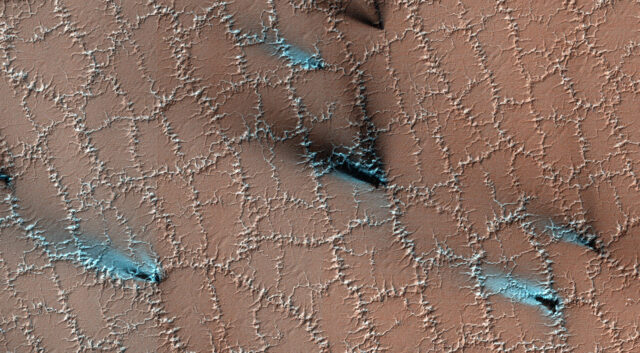NASA Takes the Sting Out of Cold Weather on Earth By Detailing Winter on Mars

As a spate of nasty winter weather has buffeted much of the US in the past week, NASA is reminding us how much worse it could be. You could be living on Mars, which some people inexplicably want to do. Temperatures on the red planet can drop as low as -189 degrees Fahrenheit (-123 degrees Celsius), producing cubic snowflakes in the depth of winter and geysers of carbon dioxide as springtime approaches. Sounds lovely, right?
Scientists believe that Mars had a more temperate climate billions of years ago, but today it’s a frigid wasteland with a thin atmosphere composed mostly of carbon dioxide. However, there’s enough atmosphere that it does snow during winter. According to NASA, there are two kinds of snow on Mars: water ice and dry (carbon dioxide) ice. You’ll never find a patch of water ice snow as it sublimates (transitions from solid to gas) before it can reach the surface. Dry ice snow, on the other hand, falls in great enough quantities that you could snowshoe across it. If you found the right crater rim shielded from sunlight, you might even be able to ski down it.
The shape of snowflakes is a reflection of the conformation of molecules when they freeze. Water forms a hexagonal crystal, so the snowflakes on Earth have six sides. However, the snow on Mars is cubic in shape. That’s a result of the shape of carbon dioxide crystals, which have four sides. Dry ice snowflakes are very small, though. Data from the Mars Climate Sounder suggests Martian snowflakes are smaller than the width of a human hair.
[embedded content]
Mars has a longer year than Earth does — about 687 Earth days. The planet’s last winter happened in the summer of 2022, and it’s currently smack in the middle of spring. The transition from winter to spring on Earth means rain showers and blooming plants, but not so on Mars. As dry ice builds up on the surface of Mars, it will coat large swaths of the surface, but it doesn’t block light like water ice. At the end of winter, the sheet of translucent dry ice begins to crack to form a patchwork pattern (see top), and gaseous carbon dioxide under the surface warms in the sunlight. The gas eventually bursts through as a geyser, blasting dust and debris upward. Scientists are beginning to focus more on these “spring fans” to study winds on Mars.
According to NASA’s Curiosity rover, the daily high temperature on Mars is currently hovering between 0 and 20 degrees Fahrenheit (about -17 to -6 Celsius). That’s warmer than it’s been in some parts of the US lately. But come next summer, we’ll be basking in the heat on Earth while it snows carbon dioxide on Mars.
Now read:

Comments are closed.